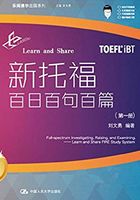
Day 6
Passage 6
Rain Forest Animals
① Rain forest refers to woodland, characterized by lush vegetation and comparatively high temperature and rainfall throughout the year. Rain forests are the world's most biologically diverse ecosystems. Their ecosystems contain more plant and animal species than virtually any other habitat in the world. One study found more species of ants living on a single rain forest stump than those that exist in all of the British Isles. Besides, although their range has contracted and expanded with climate changes over the last several million years, in general, rain forests are some of the oldest ecosystems on Earth. As a result of this continuity, rain forests boast millions of different species, many of which are endemic, or unique, to rain forest habitats.
② Of the richly diverse inhabitants of rain forests, almost 10 percent of these species are insects, and of these, most are beetles. A single rain forest tree can host more than 110 species of beetles. Living high in the forest canopy, most of these beetles and other insect species have eluded scientists until recently, when technology has improved access to the upper stratum. To this day, scientists are unsure as to how many animal species exist in the world, largely because they have identified just a small fraction of the millions—some estimate as many as 10 million—of insects that live in the rain forest.
③ Among the most fascinating rain forest insects yet encountered are leafcutter ants, remarkable because they actually cultivate their own food. These ants cut the leaves of particular plants and carry them back to their underground nests, where they fertilize them with saliva. This careful tending causes growth of a particular fungus, which the ants harvest and rely on as their sole source of food.
④ Aside from insects, as many as 100 different mammal species may be found in a 11 sq. km (6 sq. mi) of r ain forest. These animals occupy every available niche, from burrows in the forest floor to the branches of emergent trees. Most rain forest mammals are nocturnal (active during the night) or crepuscular (active during the twilight of dusk or dawn), and they spend the heat of the day sleeping. In fact, almost half of the mammals of the rain forest are bats, flying mammals known for their nighttime activity. Some rain forest mammals, including gorillas, elephants, tapirs, agoutis, and wild pigs, are ground-dwellers, but most, like their insect counterparts, live high in the treetops in the forest canopy. Canopy-dwellers have evolved an array of fascinating traits to survive in the branches of the trees. For instance, some Asian rain forests are especially known for animals with the ability to glide. Borneo alone has more than 10 species of mammals, reptiles, and amphibians that can glide from one tree to another. Most rain forest monkeys in Central and South America use their specialized tails, which are capable of grasping branches, like a fifth limb while climbing, feeding, and even playing high above the forest floor.
⑤ Unlike the agile monkeys, the three-toed sloth spends most of its life defenseless, hanging upside down from tree branches. To avoid predators, its movements are generally very slow, so much so that they are virtually undetectable to would-be predators, even vigilant jaguars.【1】The sloth has also developed a relationship with a rain forest plant that makes it even more elusive to its predators: Although it has brown fur, the sloth blends in with the surrounding green canopy because a particular species of green alga lives in its fur.
——2012年 7月 6日北美机经
The word“eluded” in Paragraph 2 is closest in meaning to ______ .
A. avoid
B. evade
C. baffle
D. beat



词汇练习:
阅读下列句子,用所给单词(或词组)的正确形式填空:
stratum
niche
habitat
glide
cultivate
counterpart
canopy
virtually
comparatively
1. Because the flippers are ______ thin and blade-like, they are the one part of the leatherback that is likely to become chilled.(TPO-11: A Warm-Blooded Turtle)
2. The ants benefit the host tree by attacking ______ anything that touches it.(TPO-17: Symbiotic Relationships)
3. But the Maya homeland lies more than sixteen hundred kilometers from the equator, at latitudes 17 to 22 degrees north, in a ______ termed a“seasonal tropical forest.”(TPO-14: Maya Water Problems)
4. Very little light filters through the ______ of leaves and branches in a rain forest to reach ground level—or close to the ground—and at those levels the yellow-to-green wavelengths predominate.(TPO-17: Animal Signals in the Rain Forest)
5. Some fossils endured through so many millions of years that they appear in many strata, but others occur only in a few strata, and a few species had their births and extinctions within one particular ______.(TPO-6: William Smith)
6. Whole villages began to ______ fruit and vegetables.(TPO-21: Seventeenth-Century Dutch Agriculture)
7. Even if the new population is of a different species, it can approximately fill the ______ vacated by the extinct population and keep the food web intact.(TPO-1: The Long-Term Stability of Ecosystems)
8. However, Martian craters get filled in considerably faster than their lunar ______.(TPO-21: The surface of Mars)
9. They can ______ past eddies that would slow them down and then gain extra thrust by “pushing off” the eddies.(OG: Swimming Machines)
参考答案:
1. comparatively
2. virtually
3. habitat
4. canopy
5. stratum
6. cultivate
7. niche
8. counterparts
9. glide
【1】与今日百句译(Sentence 6)相同的句型。